 |
 |
 |
 |
 |
 |
 |
| Ghettos |
In September 1939 a part of the town was destroyed by the German Luftwaffe and about 25% of Jewish housing was destroyed. The German army entered the town on 13 September 1939 for the first time but after several days the Soviet Army occupied Miedzyrzec. The Soviets remained in the town until 25 September 1939, before leaving. 2,000 young Jews joined them.
German Wehrmacht units again entered the town on 9 October 1939. Shortly after the German occupation of Miedzyrzec Podlaski, the Jews were forced to leave the centre of the town. They had to move to the Jewish district, located in the poorest neighbourhood. Around 1,800 people had to vacate their homes.
"They went into small apartments, already overcrowded. These apartments were without privacy, water and sanitation. Water had to be carried from the wells in the streets. In 1940 a dysentery epidemic broke out." (Fragment of the report by the Committee of Jüdische Soziale Selbsthilfe (JSS) in Miedzyrzec, from the beginning of 1941).
In the same manner as in other ghettos, a Judenrat and a Jewish police force were established in the town. Klarberg became president of Miedzyrzec's Judenrat.
 |
| Postcard from 6 June 1940 |
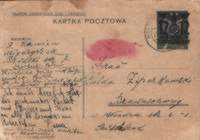 |
| Postcard from 19 June 1940 |
According to the JSS report from early 1941, 6 - 8 people died from starvation every day. The daily bread ration was 100 grams (working Poles received 260 grams).
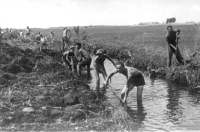 |
| Working for WWI #1 * |
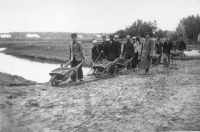 |
| Working for WWI #2 * |
In 1942, when Aktion Reinhard began, the Miedzyrzec Ghetto became the main transit ghetto in the northern part of the Lublin district. From this transit ghetto, the Jews were deported to the Treblinka death camp.
Before the deportations to Treblinka began, more Jews were resettled in Miedzyrzec: around 500 from Mielec in March 1942 and 1,001 Slovakian Jews on 8 May 1942. On 2 August 1942, 17,546 Jews were concentrated in Miedzyrzec.
Before the first deportation from Miedzyrzec began, the local Jews were ordered to hand over 50 kilograms of gold within 3 days. To encourage this extortion, the Gestapo from Radzyn shot 40 Jews in the streets.
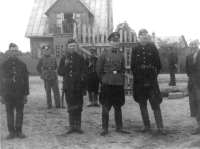 |
| German Police and Accomplices * |
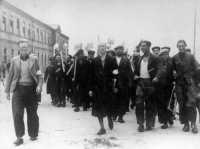 |
| Forced Labour * |
The deportees were crammed into overcrowded cattle cars (120 - 140 per wagon). Most of them died before they arrived in Treblinka.
The first transport from Miedzyrzec was described very well by one of the survivors from Treblinka, Abraham Krzepicki. When the prisoners (Treblinka special command) opened the cattle cars, they discovered only dead people.
The bodies of the shot Jews in Miedzyrzec were burned shortly after the Aktion by a special group of Jews from the ghetto.
This deportation was the biggest Aktion carried out by the 101st Reserve Police Battalion in the Lublin district. After this Aktion the German policemen started to call Miedzyrzec Menschenschreck (Men Horror) because "Miedzyrzec" was too difficult to pronounce for them.
Within a short time this German expression became a synonym for the cruelties inflicted by the police battalions.
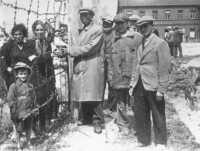 |
| Ghetto Fence * |
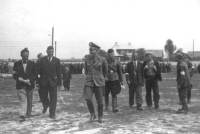 |
| Assembling for Deportation * |
The second Aktion took place between 6 and 9 October 1942. Together with the ghetto residents, several hundreds of resettled Jews from the entire Radzyn county were assembled on the market square and selected for Treblinka. The selected deportees were locked in the synagogue for several days. Rywka Rybak, a survivor from the Miedzyrzec Ghetto, described the conditions in this synagogue:
"There was no food or water in the temple. My mother was also there. I don't know how she could survive there. My aunt told me there were constant screams and people dying inside that temple. They were dying of thirst and hunger. The screams went to heaven." During this Aktion around 5,000 people were selected and deported.
Around 150 women and children were executed at the Jewish cemetery in course of this Aktion, since there was insufficient space in the cattle cars...
The whole Aktion was observed by local non-Jewish Poles. They also witnessed the executions at the cemetery. Many of them were very interested in this "show"...
Two members of this deportation escaped from Treblinka and returned to Miedzyrzec. They informed others about the fate of the Miedzyrzec Jews. From that time the ghetto people started building "bunkers" and tried to escape to the surrounding forests. The Treblinka fugitives were finally denounced by Judenrat members and shot by the Gestapo.
Brush workshops were established in the ghetto in 1942. The special brush workers were temporarily released from the deportations. In other workshops the Jews were forced to produce baskets for ammunition.
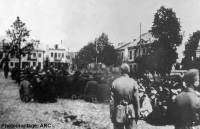 |
| Assembling for Treblinka |
After this deportation only 1,000 Jews remained in Miedzyrzec. At this time Jews from the surrounding villages and those who hid in the forests decided to return to the ghetto because they thought that no more "actions" would be carried out.
According to an order of the "SS and Police Commander in the Generalgouvernement, Krüger, Miedzyrzec was to be one of the Rest Ghettos in the Lublin district.
Joel Schupack, who survived the Radzyn and Miedzyrzec ghetto selections, gave a good description of the ghetto situation between the end of 1942 and early 1943:
"At this time there was no Judenrat, no administration. Only the brutal Jewish police force, known as Gestapo helpers. There was no registration, no hygienic facilities, no fuel or heat and no food. People lived on the reserves of their predecessors, if they found any or they would smuggle which usually entailed the involvement of the Jewish police. It was said that they would drink with the Polish police."
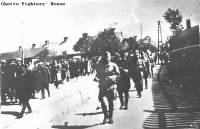 |
| To Majdanek |
Relative quiet then prevailed in the ghetto for the next months. But a fifth Aktion took place on 30 April 1943. The Jews were gathered on the market square and around 1,000 people were deported to Majdanek. During this Aktion the last members of the Judenrat and the Jewish police were executed.
On 26 May 1943 another group of around 700 - 1,000 people were deported to Majdanek. Only 200 Jews remained in the ghetto. They had to clean the empty Jewish houses. Some people from this group later escaped to the forests. The final liquidation of the ghetto occured on 17 July 1943. The last 170 Jews were executed at the Jewish cemetery and the town was declared judenfrei (free of Jews) by the German authorities.
During 1942 - 1943, around 24,000 Jews passed through the Miedzyrzec Ghetto. Only 1% of the pre-war Jewish population of Miedzyrzec survived the Holocaust.
Photos:
GFH
Mezritch (Miedzyrzec) Internet Bulletin Edited By Dr Naphtali Brezniak *
Sources:
Jewish Historical Institute in Warsaw: The collection of Jüdische Soziale Selbsthilfe and the testimonies by survivors.
Archive of the State Museum Majdanek: The memoirs and testimonies by survivors.
Rywka Rybak: A Survivor of the Holocaust. Cleveland 1993.
Joel Schupack: The Dead Years. Holocaust Library 1996.
Christopher R. Browning: Ordinary Men. 101. Reserve Police Battalion and the Final Solution in Poland. HarperCollins Publishers 1998.
www. mezritch.org.il
 |
| 24,000 Jews lived in the ghetto |
© ARC 2005